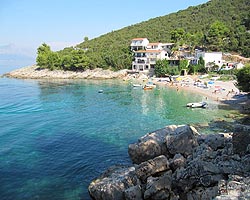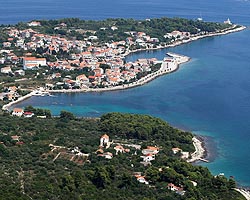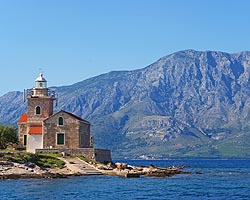Island of Hvar, Sućuraj - Sights
¦ Parish church of St. George ¦ Franciscan monastery ¦ St. Anthony's church ¦ Fort Fortica ¦ Lighthouse ¦ Statue of St. Nicholas ¦ Large graphite ¦ Statues in the park ¦ Monument to the victims ¦ Cross with altar ¦ Chapels ¦ Cemeteries ¦ Procession on Good Friday ¦ Christmas Eve ¦
Parish church of St. George

 - built in 1897 in neoromanic style. In terms of layout, the church has a cross shape. The main entrance is facing south and the belfry has three bells. The main altar is dedicated to St. George, from whom the town gets its name. The west altar is dedicated to Our Lady of Health, whose statue in carried in the procession on her holiday thru the town. The east altar, transferred from the old church is dedicated to Our Lady of the Belt.
- built in 1897 in neoromanic style. In terms of layout, the church has a cross shape. The main entrance is facing south and the belfry has three bells. The main altar is dedicated to St. George, from whom the town gets its name. The west altar is dedicated to Our Lady of Health, whose statue in carried in the procession on her holiday thru the town. The east altar, transferred from the old church is dedicated to Our Lady of the Belt.  On the main altar, among other things, is the statue of St. George killing the dragon. The same motive is also present on the large round painting on the selling and on the church flag, located on the right of the altar, with an inscription: “St. George guard Sućuraj”. In the front yard of the church one can still see the foundations of the old church which was also dedicated to St. George. It is unknown when the old church was built, but there is mention of it in the Baylaw of the city of Hvar in 1331. It was demolished due to frazzle in the late 19th century during the built of the new church. Just left of the entrance to the church yard there is a memorial plaque written in Croatian version of the Cyrillic script called bosančica, dedicated to the bishop, father Bartul Kačić Žarković, set by the duke Petar Kulušić.
On the main altar, among other things, is the statue of St. George killing the dragon. The same motive is also present on the large round painting on the selling and on the church flag, located on the right of the altar, with an inscription: “St. George guard Sućuraj”. In the front yard of the church one can still see the foundations of the old church which was also dedicated to St. George. It is unknown when the old church was built, but there is mention of it in the Baylaw of the city of Hvar in 1331. It was demolished due to frazzle in the late 19th century during the built of the new church. Just left of the entrance to the church yard there is a memorial plaque written in Croatian version of the Cyrillic script called bosančica, dedicated to the bishop, father Bartul Kačić Žarković, set by the duke Petar Kulušić.
The Franciscan monastery
 - was probably built in the 9th century. The monastery was Augustinian at first and today is Franciscan, and it is the oldest preserved building in Sućuraj. Over the entrance gate of the monastery there is a sign that reads: “The monastery of the brothers of the order of St. Augustine rebuilt in 1309” (translation from Latin). The monastery was destroyed and rebuilt many times with the last renovation in 1994. It is presently being occupied by Franciscans from the province of Bosnia who perform the parish duties for Sućuraj, Bogomolje and Gdinj. There is a rectory in the monastery with an archive of important documents and in the monastery treasury a large roman mosaic found on its grounds.
- was probably built in the 9th century. The monastery was Augustinian at first and today is Franciscan, and it is the oldest preserved building in Sućuraj. Over the entrance gate of the monastery there is a sign that reads: “The monastery of the brothers of the order of St. Augustine rebuilt in 1309” (translation from Latin). The monastery was destroyed and rebuilt many times with the last renovation in 1994. It is presently being occupied by Franciscans from the province of Bosnia who perform the parish duties for Sućuraj, Bogomolje and Gdinj. There is a rectory in the monastery with an archive of important documents and in the monastery treasury a large roman mosaic found on its grounds.
St. Anthony's church

 - was built in 1663. In the 16th and 17th century many refugees from the mainland, fleeing the Ottomans, settled in Sućuraj and with the Franciscans built this church. In addition to the church they built the monastery, now a family house. St. Anthony's church guards the oldest painting in Sućuraj which represents St. Paškal, Our lady of Karmel and St Roko and is probably the work of artisan Philip Nadij from the 18th century. The church also contains an archeological collection of amphorae and an anchor from a sunken roman galley. Interestingly, there are two statues of St. Anthony: St. Anthony of Padova (to whom the church id dedicated) and St. Anthony the Monk. In folk stories these two are known as “St. Anthony the thin” and “St. Anthony the fat”. Alongside these, there is also statue of St Nicholas, a saint worshiped in Sućuraj, along with St. Anthony and St George. The statue of St. Anthony of Padova is carried every year thru the town on St. Anthony holiday, as well as St. Nicholas statue on his holiday.
- was built in 1663. In the 16th and 17th century many refugees from the mainland, fleeing the Ottomans, settled in Sućuraj and with the Franciscans built this church. In addition to the church they built the monastery, now a family house. St. Anthony's church guards the oldest painting in Sućuraj which represents St. Paškal, Our lady of Karmel and St Roko and is probably the work of artisan Philip Nadij from the 18th century. The church also contains an archeological collection of amphorae and an anchor from a sunken roman galley. Interestingly, there are two statues of St. Anthony: St. Anthony of Padova (to whom the church id dedicated) and St. Anthony the Monk. In folk stories these two are known as “St. Anthony the thin” and “St. Anthony the fat”. Alongside these, there is also statue of St Nicholas, a saint worshiped in Sućuraj, along with St. Anthony and St George. The statue of St. Anthony of Padova is carried every year thru the town on St. Anthony holiday, as well as St. Nicholas statue on his holiday.
The Fort called Fortica
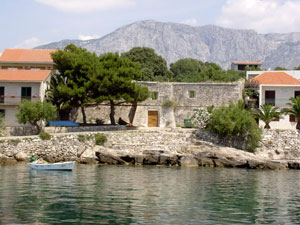 - was built in 1623, after the Ottomans plundered and burned down the village three times. During the Venetian-Ottoman wars Sućuraj was on the border of three countries: Venetian Republic (whom Sućuraj was a part of), Ottoman Empire (which held the coastline surrounding Makarska) and the Republic of Dubrovnik (which held the Pelješac peninsula). The fort was built in order to protect the port and the village and it was equipped with cannons and standing military crew what secured a much safer life for the inhabitants of Sućuraj. The fort was heavily damaged in the WWII, in the Allies bombardment of Sućuraj on March 24th 1944, what resulted in complete destruction of the tower, the interior and a large porting of defense walls. The appearance of the fort prior to the bombing can be seen in this photo.
- was built in 1623, after the Ottomans plundered and burned down the village three times. During the Venetian-Ottoman wars Sućuraj was on the border of three countries: Venetian Republic (whom Sućuraj was a part of), Ottoman Empire (which held the coastline surrounding Makarska) and the Republic of Dubrovnik (which held the Pelješac peninsula). The fort was built in order to protect the port and the village and it was equipped with cannons and standing military crew what secured a much safer life for the inhabitants of Sućuraj. The fort was heavily damaged in the WWII, in the Allies bombardment of Sućuraj on March 24th 1944, what resulted in complete destruction of the tower, the interior and a large porting of defense walls. The appearance of the fort prior to the bombing can be seen in this photo.
Sućuraj lighthouse
- was built in 1889 and is still in function today. It is located on the most eastern peak of the island of Hvar, less than a kilometer from the town center.  In the vicinity of this lighthouse once stood an even older one, but it was destroyed in the WWII. The light on the lighthouse was automated in the 1990's, after which the lighthouse crew became expendable . Before that the lighthouse keepers lived in the lighthouse with their families, especially those with school –age children due to the vicinity of the town school. The lighthouse is one of the signature landmarks of Sućuraj and an incentive for many amateur photographers.The building has sinds been redecorated and is now available as a holiday let for tourists. More info on page Lighthouse Sućuraj.
In the vicinity of this lighthouse once stood an even older one, but it was destroyed in the WWII. The light on the lighthouse was automated in the 1990's, after which the lighthouse crew became expendable . Before that the lighthouse keepers lived in the lighthouse with their families, especially those with school –age children due to the vicinity of the town school. The lighthouse is one of the signature landmarks of Sućuraj and an incentive for many amateur photographers.The building has sinds been redecorated and is now available as a holiday let for tourists. More info on page Lighthouse Sućuraj.
Statue of St. Nicholas on the breakwater
 - was placed in 2003, just prior to St. Nicholas’s holiday. It is located on the end of the old part of the pier built in 1870. St. Nicholas is patron saint of seamen, travelers and fishermen, which is important in Sućuraj as it is traditionally a town of seamen and fishermen . The statue is bronze, 3,2 meters tall and is a work of academic sculptor Dijana Iva Sesarić from Solin. The cast of the statue was made in Vele Luka on the island of Korčula by Vladimir Šeparović. The solemn blessing of the statue was on December 6th 2003 and photo reportage of the ceremony can be seen here.
- was placed in 2003, just prior to St. Nicholas’s holiday. It is located on the end of the old part of the pier built in 1870. St. Nicholas is patron saint of seamen, travelers and fishermen, which is important in Sućuraj as it is traditionally a town of seamen and fishermen . The statue is bronze, 3,2 meters tall and is a work of academic sculptor Dijana Iva Sesarić from Solin. The cast of the statue was made in Vele Luka on the island of Korčula by Vladimir Šeparović. The solemn blessing of the statue was on December 6th 2003 and photo reportage of the ceremony can be seen here.
Large graffiti on the breakwater
 - in the summer of 2013, Stjepan Voženilek Chipy, a great enthusiast of graffiti and Sućuraj, drew a graffiti on a concrete wall of the new part of the breakwater. The graffiti is 45 meters long, 2,2 meters high and is, according to the author, longest independent graffiti in Dalmatia. The technique used to draw it is spray (Montana Black and Montana Gold). The central part of the graffiti makes the inscription SUĆURAJ, on the left side there is the municipality crest (St. George on a horse killing a dragon) and on the right side there is a crest of Mladost, the football team from Sućuraj which plays in Hvar football league.
- in the summer of 2013, Stjepan Voženilek Chipy, a great enthusiast of graffiti and Sućuraj, drew a graffiti on a concrete wall of the new part of the breakwater. The graffiti is 45 meters long, 2,2 meters high and is, according to the author, longest independent graffiti in Dalmatia. The technique used to draw it is spray (Montana Black and Montana Gold). The central part of the graffiti makes the inscription SUĆURAJ, on the left side there is the municipality crest (St. George on a horse killing a dragon) and on the right side there is a crest of Mladost, the football team from Sućuraj which plays in Hvar football league.
Statues in the park
 - were placed in 1999. The small park in the centre of the town holds 3 stone statues: a woman with a fish (called Šofija), stone water drops and a monument to the old school. The old school and township building was located on the site of the park, built in 1888 and was the most beautiful building in town. By the end of WWII the building housed a German garrison. The Germans blew the building up on September 21st 1944 as they were leaving so that nothing of it remained and the appearance of the building can be seen here. The three statues were made in the summer of 1997 when Ivona Biočić held a summer school of sculpture.
- were placed in 1999. The small park in the centre of the town holds 3 stone statues: a woman with a fish (called Šofija), stone water drops and a monument to the old school. The old school and township building was located on the site of the park, built in 1888 and was the most beautiful building in town. By the end of WWII the building housed a German garrison. The Germans blew the building up on September 21st 1944 as they were leaving so that nothing of it remained and the appearance of the building can be seen here. The three statues were made in the summer of 1997 when Ivona Biočić held a summer school of sculpture.
Monument to the victims of Second World War
 - was placed in 1996. It is located in a small park near elementary school and the infirmary. In WWII Sućuraj was heavily damaged. 40 people were killed locally and another 18 died in exile. In memory of them this monument was placed.
- was placed in 1996. It is located in a small park near elementary school and the infirmary. In WWII Sućuraj was heavily damaged. 40 people were killed locally and another 18 died in exile. In memory of them this monument was placed.
Stone cross with altar
 The stone cross with altar in the port was made in 1991 and was blessed in June 13th the same year. On the same place once stood a similar cross made 1872 in memory of Jesuit mission but was torn down after WWII on communist authority.
The stone cross with altar in the port was made in 1991 and was blessed in June 13th the same year. On the same place once stood a similar cross made 1872 in memory of Jesuit mission but was torn down after WWII on communist authority.
Chapels
 There are a few small chapels surrounding Sućuraj:
There are a few small chapels surrounding Sućuraj:
- Our Lady of Karmel, on the top of Gornja Banda
- St. Nicholas (lower), 50 meters west of the soccer field
- St. Nicholas (upper) on the Hill (above Gojmera)
- St. Špiridijun, on Mačak peak, between Česminica bay and Valica bay
- St. Michael, on the Lečevišća area (north of Perna bay)
- Our lady of Health and St. Nicholas (joined), on the Bočić area (east peak of Mrtnovik bay)
- etc.
Cemeteries
 In Sućuraj there are two cemeteries - the new and the old one. The main cemetery (new) in Sućuraj, built in 1923, is located on the road to the east peak, between the town and the lighthouse. Although first built in 1923 it was enlarged in the 1960's and 1970's. The old cemetery was in use from 1816 to 1923, with an occasional burial in later years. The east part of the old cemetery holds a few graves in the shape of small houses, which is a remnant of old roman customs.
In Sućuraj there are two cemeteries - the new and the old one. The main cemetery (new) in Sućuraj, built in 1923, is located on the road to the east peak, between the town and the lighthouse. Although first built in 1923 it was enlarged in the 1960's and 1970's. The old cemetery was in use from 1816 to 1923, with an occasional burial in later years. The east part of the old cemetery holds a few graves in the shape of small houses, which is a remnant of old roman customs. 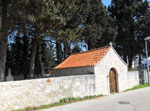 The west part of the cemetery holds a few tombstones called “bogumilski stećci” which are similar to those in Makarska's coast, Dalmatian inland, Herzegovina and Bosnia, from where a large portion of locals originated. Prior to the construction of this old cemetery, people were buried in front of the old St. George's and St. Anthony's churches as well as within them.
The west part of the cemetery holds a few tombstones called “bogumilski stećci” which are similar to those in Makarska's coast, Dalmatian inland, Herzegovina and Bosnia, from where a large portion of locals originated. Prior to the construction of this old cemetery, people were buried in front of the old St. George's and St. Anthony's churches as well as within them.
Procession on Good Friday
 On the eve of Good Friday, two days before Easter, there is a traditional and unique procession, in the memory of the torment and death of Jesus Christ. The procession begins from the parish church of St. George. The main cross bearer is dressed in black robes, holds a large black cross on his shoulders and a black hood on his head, so only his eyes can be seen. The cross bearer, whose name is kept a secret, leads the procession. He is followed by the rest of the cross bearers, who carry all the crucifixes from the church. They are followed by a priest with a monstrance. Above the priest there is canopy carried by four bearers, and on both sides there are three lamps. The rest of the procession consists of the people singing and praying all the way. The procession passes thru Gornja Banda, stops on the small square in front of the post office, continues across the port and stops for the second time in front of St. Anthony's church and continues again through Donja Banda to the cross in the port
On the eve of Good Friday, two days before Easter, there is a traditional and unique procession, in the memory of the torment and death of Jesus Christ. The procession begins from the parish church of St. George. The main cross bearer is dressed in black robes, holds a large black cross on his shoulders and a black hood on his head, so only his eyes can be seen. The cross bearer, whose name is kept a secret, leads the procession. He is followed by the rest of the cross bearers, who carry all the crucifixes from the church. They are followed by a priest with a monstrance. Above the priest there is canopy carried by four bearers, and on both sides there are three lamps. The rest of the procession consists of the people singing and praying all the way. The procession passes thru Gornja Banda, stops on the small square in front of the post office, continues across the port and stops for the second time in front of St. Anthony's church and continues again through Donja Banda to the cross in the port  (where it stops for the third time) and the fourth stop is in front of St. George's church. After that the procession enters the church where people continue with song and prayer. During every one of the stops, the priest gives blessing and people rattle with traditional rattles called “škrgotaljke”. This device, known outside of Sućuraj as “čegrtaljka”, is a wooden devise used to make a big noise, and it is used in the end of Holy Week, when church bells do not ring.
(where it stops for the third time) and the fourth stop is in front of St. George's church. After that the procession enters the church where people continue with song and prayer. During every one of the stops, the priest gives blessing and people rattle with traditional rattles called “škrgotaljke”. This device, known outside of Sućuraj as “čegrtaljka”, is a wooden devise used to make a big noise, and it is used in the end of Holy Week, when church bells do not ring.
Christmas Eve

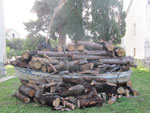 On the night of Christmas Eve a great fire (called “Badnjak” in Croatian) is lit on the west side of St. George's church. The wood for the fire is gathered in the woods or an old wooden ship is brought. The custom dictates that the fire is grand, so a large amount of wood is needed. The fire is lit at 6 PM,
On the night of Christmas Eve a great fire (called “Badnjak” in Croatian) is lit on the west side of St. George's church. The wood for the fire is gathered in the woods or an old wooden ship is brought. The custom dictates that the fire is grand, so a large amount of wood is needed. The fire is lit at 6 PM,  after which Christmas carols are sung. The custom dates from pre-Christian time when fire was lit because the nights were getting longer and the day needed help in defeating the night. Prior to WWII the custom was to light the Christmas Eve fire in the port.
after which Christmas carols are sung. The custom dates from pre-Christian time when fire was lit because the nights were getting longer and the day needed help in defeating the night. Prior to WWII the custom was to light the Christmas Eve fire in the port.











